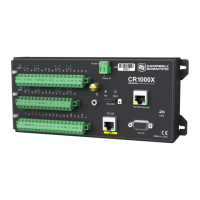6.6.2.1 P terminals
l CRBasic instruction: PulseCount()
High-frequency pulse inputs are routed to an inverting CMOS input buffer with input hysteresis.
See Pulse measurement specifications (p. 169) for more information.
6.6.2.2 C terminals
l CRBasic instructions: PulseCount()
6.6.3 Switch-closure and open-collector measurements
Switch-closure and open-collector (also called current-sinking) signals can be measured on P or
C terminals. Mechanical switch-closures have a tendency to bounce before solidly closing. Unless
filtered, bounces can cause multiple counts per event. The datalogger automatically filters
bounce. Because of the filtering, the maximum switch-closure frequency is less than the
maximum high-frequency measurement frequency. Sensors that commonly output a switch-
closure or an open-collector signal include:
l Tipping-bucket rain gauges
l Switch-closure anemometers
l Flow meters
The datalogger has built-in pull-up and pull-down resistors for different pulse measurements
which can be accessed using the PulseCount() instruction. Note that pull down options are
usually used for sensors that source their own power.
Data output options include counts, frequency (Hz), and running average.
6.6.3.1 P Terminals
An internal 100 kΩ pull-up resistor pulls an input to 5 Vdc with the switch open, whereas a
switch-closure to ground pulls the input to 0 V.
l CRBasic instruction: PulseCount()
6. Measurements 74

